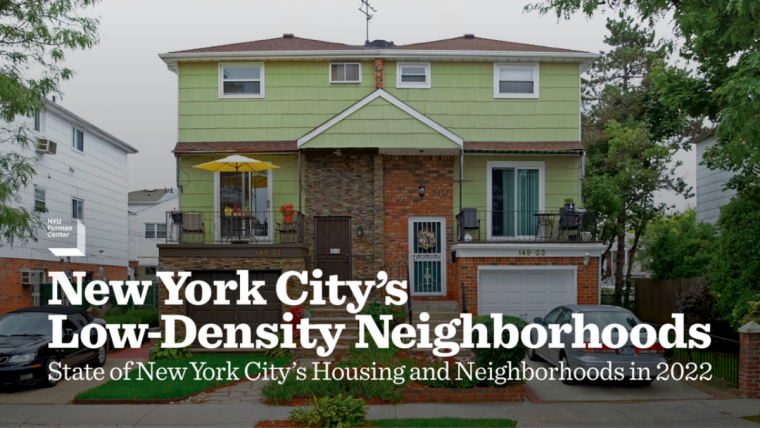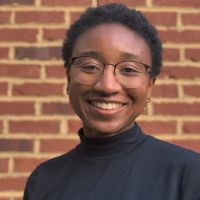
Changing Narratives and Engaging Communities Toward Better Policy: New York City’s Low-Density Neighborhoods Event Recap

New York City’s least-dense community districts are permitting new housing at lower rates compared to the rest of the city, raising questions for policymakers over how to achieve fair and equitable housing growth across a broad range of neighborhood types, according to a recent report from the NYU Furman Center.
Data analyzed by the Furman Center shows that the city’s lowest-density community districts take up 44.7 percent of the total land across the five boroughs but contain just 28.4 percent of the city’s population. What’s more, the research finds that the lowest-density community districts added housing at only half the rate of the city overall between 2010 and 2020.
Despite this mismatch, there has been little policy discussion about whether and how low-density neighborhoods should accommodate more housing and people as the city and state faces a housing crisis and what new tools policymakers should create to add more housing to these community districts.
“Our hope is that this research allows us to unpack pre-existing assumptions about these areas, points to the challenges and opportunities of low-density neighborhoods, and highlights an area of the city that rarely gets a spotlight,” said Matthew Murphy, Executive Director of the Furman Center at the By The Numbers: Focus on New York City’s Lowest Density Neighborhoods event on May 25.
Watch the full event below:
NYU Furman Center State of the City 2022 from Furman Center on Vimeo.
Complicating Demographic Housing Myths
The Furman Center’s research shows that, in aggregate, the demographics of residents who live in the lowest-density community districts are much like the city’s overall, dispelling popular conceptions.
However, some of the lowest-density community districts do have more segregated demographic patterns, with very high or very low shares of non-Hispanic white populations. When considered at the census tract level, the least-dense census tracts within the least-dense community districts also had a much higher share of the population that identified as white, in addition to a much higher median income.
Lowest-density districts include neighborhoods that are anchors of homeownership for BIPOC residents, especially Black households as compared to the highest-density community districts and the city as a whole.
“Low-density community districts are anchors of homeowners for BIPOC residents, especially Black New Yorkers,” said Murphy. “More than half of the city’s Black households reside in the most dense neighborhoods, the highest share of any race/ethnicity group by U.S. Census Bureau data.”
Of all the Black households who reside in the lowest-density community districts, nearly half own their home. That is a much higher share compared to the highest-density community districts, where only 10 percent of Black households own their home.
Despite these facts, there are still disparities in the homeownership rate by race and ethnicity in all neighborhood types. For example, the homeownership rate for white households who reside in lowest-density community districts is 68 percent. The homeownership rate is far lower for Hispanic of any race households at around 30 percent.
Hitting the “Moonshot” Goal
During a panel discussion at the event, Maria Torres-Springer, Deputy Mayor for Economic & Workforce Development with the New York City Office of the Mayor said Mayor Eric Adam’s “moonshot” goal of building 500,000 new housing units over the next decade, must be a citywide effort where solutions are crafted for every district: high-density, medium-density, and low-density.
“Until we tackle the lack of overall supply in this city, I believe we will be hamstrung,” said Torres-Springer. “We need to collapse the distance between recognition that we have to boost supply and then [take] the action that is needed to actually do that.”
Panelist Yoselin Genao-Estrella, the Executive Director of Neighborhood Housing Services of Queens, agreed, arguing that low-density community districts require more policy attention. Low-density community districts, like those in Queens, are often the “first step” toward achieving the goal of households buying their first home. “It’s basically our last frontier for first-time homeowners,” she said.
Genao-Estrella suggested that policymakers should first consider how to expand and improve upon current trends in housing accessibility. “If low-density communities are having high homeownership rates, especially for African, for Black, and also BIPOC communities, why not enhance it? Why not...utilize this vacant [land]?” At the same time, past discriminatory actions like redlining and the racialized targeting of subprime loans have drastically impacted locational patterns and economic outcomes for people of color in America, and may continue to influence current trends in the geography of BIPOC homeownership.
Addressing Gentle Density
The least disruptive way to add housing capacity to low-density community districts may be to identify underused land that may be suitable for housing. The Furman Center’s research shows about 15 percent of the land in the lowest-density community districts is either vacant or used for commercial or office buildings.
Aside from such underused sites, meeting the growth targets proposed by policymakers can be accomplished via “gentle density.” The Furman Center’s research shows that even a simple change to the city's zoning law would allow accessory dwelling units to be available for more than 376,000 single- and two-family homes in those districts. That would be enough to meet a one percent annual growth target if only 2.4 percent of those properties added an accessory dwelling unit.
“We really need to show the ways in which [gentle density] can happen and that they're not nearly as scary as many opponents let on,” said Vicki Been, a Faculty Director at the NYU Furman Center, and Judge Edward Weinfeld Professor of Law at the NYU School of Law.
Policymakers will also need to gain a better understanding of who advocates against density and why, said Torres-Springer.
“When we think about what the civic discourse needs to be, what the culture change needs to be, it isn't just a profile that we might have of, ‘Who is ‘NIMBY?’” said Torres-Springer. “And that leads us to: how do we not just better communicate, but better understand and engage with the residents across the city of what it means for everyone in every neighborhood to help address the housing crisis?”
Laura Harding, the Executive Director of ERASE Racism, also stressed that it is critical to step away from the stereotypical tropes that come with the language of housing affordability beyond “low-income” or “Brown and Black.”
“They never think of the seniors who can no longer afford to live in their homes and want to remain in their communities,” said Harding. “They never think of young professionals with high student loan debt, who don't want to live at home, but certainly want to live in a nice neighborhood.”
Engaging Community
Panelists said meaningful community engagement must be the cornerstone of any effective housing strategy through proactive policy processes, increased representation, and regional participation.
“When it comes to the communities that we work with – and that I am from – many of them have been in a reactionary mode all the time,” said Genao-Estrella. “We are skeptical of proposals that say one thing, but then at the end have unintended consequences because they were only patches, they were bandages to a bigger wound that were of a historical nature.”
Harding said while many housing advocates in New York do great work, she emphasized the role of representation in advocacy would help build trust with communities. “When the housing advocates don't look like you, it feels like someone is coming into your neighborhood and making decisions for you and about you,” she said.
Panelists also weighed in on how the suburbs of New York City should be part of the solution in reaching the region’s housing production goals.
Residents across many communities, said Harding, need more government outreach to help increase their knowledge of the types of housing solutions available to their neighborhoods to be more receptive to new housing. Been added that participation by the suburbs of New York City would also be essential in addressing the state’s housing crisis.
“We can’t just accept that New York City will step up and provide more housing and the suburbs won’t,” said Been. “We just can’t let that happen.”



